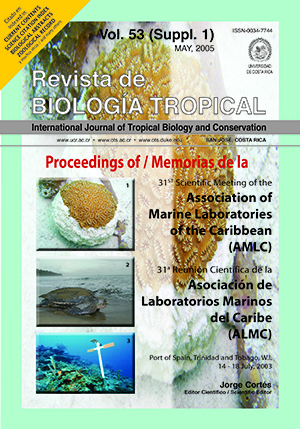Resumen
Se elaboraron mapas de Puerto Rico y las Islas Vírgenes Estadounidenses que muestran la cobertura del suelo y el fondo en arrecifes de coral (“mapas cima-mar) con imágenes del año 2000 del Enhanced Thematic Mapper (ETM+) del satélite Landsat 7. Se fusionaron Modelos de Elevación Digital con batimetría satelital. Se caracterizaron hábitats bentónicos con clasificaciones “no supervisadas” de imágenes de Landsat, agrupando mediante datos de campo, y produciendo mapas con una precisión superior al 75% (coeficiente Tau >0.65). Estas caracterizaciones se combinaron con datos de Geocover-LC (uso /cobertura del suelo) para hacer los mapas. Comparando pares de imágenes mediante Análisis de Componentes Principales se logró identificar las zonas de cambios en los ambientes marinos en dos períodos: 2000 a 2001 y 1991 a 2003. Se demostró la capacidad de las imágenes del satélite Landsat para producir mapas continuos cima-mar y para detectar cambios en los ambientes marinos someros, proveyendo así una valiosa herramienta para el monitoreo, el manejo y conservación efectiva de la zona costera.Citas
Capolsini, P., S. Andréfouët, C. Rion & C. Payri. 2003. A comparison of Landsat ETM+, SPOT HRV, IKONOS, ASTER, and airborne MASTER data for coral reef habitat mapping in south Pacific islands. Can. J. Remote Sens. 29: 187-200.
Legendre, P. & L. Legendre. 1998. Numerical Ecology. Elsevier Science, Amsterdam. 853 p.
Liceaga-Correa, M.A. & J.I. Euan-Avila. 2002. Assessment of coral reef bathymetric mapping using visible Landsat Thematic Mapper data. Int. J. Remote Sens. 23: 3-14.
Mumby, P.J. 2000. Image classification and habitat mapping, p. 141-154. In A.J. Edwards (ed.). Remote Sens. Handbook Trop. Coast. Manag., Coast. Manag. Sourcebooks 3. UNESCO, Paris.
Mumby, P.J. & C. Clark. 2000. Radiometric correction of satellite and airborne imagery, p. 93-108. In A.J. Edwards (ed.). Remote Sens. Handbook Trop. Coast. Manag., Coast. Manag. Sourcebooks 3. UNESCO, Paris.
Mumby, P.J. & E. Green. 2000. Field survey: Building the link between image and reality, p. 57-66. In A.J. Edwards (ed.). Remote Sens. Handbook Trop. Coast. Manag., Coast. Manag. Sourcebooks 3. UNESCO, Paris.
Mumby, P.J. & A.R. Harborne. 1999. Development of a systematic classification scheme of marine habitats to facilitate regional management and mapping of Caribbean coral reefs. Biol. Cons. 88: 155-163.
Mumby, P.J., E.P. Green, A.J. Edwards & C.D. Clark. 1997. Coral reef habitat mapping: how much details can remote sensing provide? Mar. Biol. 130: 193-202.
Mumby, P.J., E.P. Green, A.J. Edwards & C.D. Clark. 1999. The cost-effectiveness of remote sensing for tropical coastal resources assessment and management. J. Env. Manag. 55: 157-166.
Palandro, D., S. Andréfouët, F.E. Muller-Karger, P. Dustan. C. Hu & P. Hallock. 2003. Detection of changes in coral reef communities using Landsat-5 TM and Landsat-7 ETM+ data. Can. J. Remote Sens. 29: 201-209.
Anonymous. 1979. Caribbean rum study: Effects of distillery wastes on the marine environment and treatment options. Office of Research and Development, U.S. Environmental Protection Agency(EPA). 95th Congr. Conf. Rep. 89 p.
Stumpf, R.P., K. Holdereid & M. Sinclair. 2003. Determination of water depth with high resolution satellite imager over variable bottom types. Limnol. Oceanogr. 48: 547-556.
Tucker, C.J., D. Grant & J. Dykstra. 2004. NASA’s global orthorectified Landsat data set. Photogramm. Eng. Rem. Sens. 70: 313-322.
Kendall, M.S., M.E. Monaco, K.R. Buja, J.D. Christensen, C.R. Kruer, M. Finkbeiner & R.A. Warner. 2001. Methods Used to Map the Benthic Habitats of Puerto Rico and the U.S. Virgin Islands. National Oceanographic and Atmospheric Administration, Silver Spring, Maryland, USA. (Downloaded July, 2002, http://biogeo.nos.noaa.gov/projects/mapping/ caribbean/startup.htm).
Comentarios

Esta obra está bajo una licencia internacional Creative Commons Atribución 4.0.
Derechos de autor 2005 Revista de Biología Tropical






